01 – Exploring Sound Qualities in Architectural Design
Space 1: Tram cabin
As a primary source of everyday transportation, the tram system runs in a rail network connecting different points in the city. Being in a tram allows me to experience the cacophony and exchange of sounds in Zurich between the tram’s interior and the external surroundings. The lightweight metal, air gaps, rotary joints between different cabins, windows and doors allow for this exchange of ambient sounds such as:
- Sound of footsteps at different paces from people walking on the street
- Vehicles honking, speeding past
- People talking, chatting on the tram, babies crying
- Sound of newspaper pages turning
- Rustling of clothes
- Beeping when the door of the tram opens
- Hissing and whirring sound of screeching metal when tram makes brakes or turns
The space exists in a state of flux, creating a complex sound dimension as sound reverberates and reflects not only on the material surfaces, but is also dependent on the number of people and objects obstructing sound in a space. There are multiple cabins connected at metal rotary platform joints, creating an elongated flexible tubular geometry. The unpredictability and fleetingness of some of these sounds creates an an impermanent sound quality capturing only the present moment. The constant movement of the tram and people, allows sound to be reflected in this dense, enclosed environment where some sounds echo and linger longer than others, and some appear more muffled when an array of sound of different frequencies exist in a singular space.

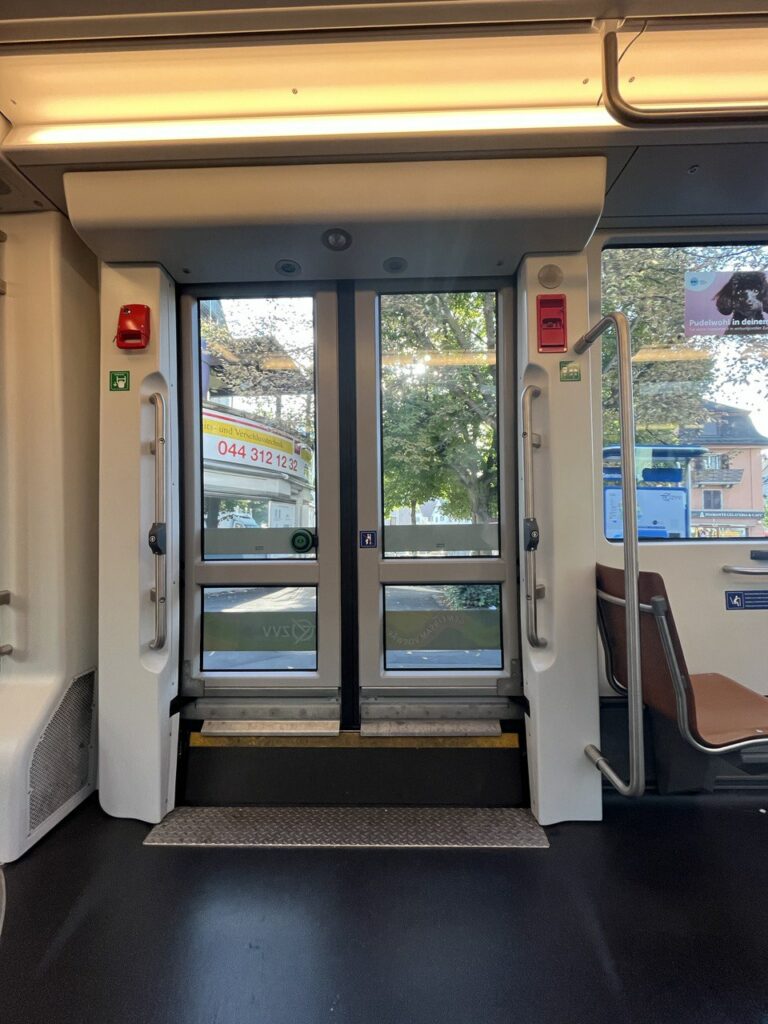
Space 2: Park with Water body

I was at Tiefenbrunnen for a swim at Lake Zurich and noticed that sound travelled across the top of the water surface extremely clearly even if it was over a relatively long distance. My friend was talking to us from the pier and I could hear their voices exceptionally well even though I was around 500m across in the lake.
I wonder how water alters our perception of sound and if it has any impact on the speed of sound. The speed of sound travels faster in denser substances. This may be the reason why sound waves travel faster across the water surface than in air.
Listening to the natural sounds at the park, I could hear
- People chatting
- Sound of the waves hitting the rocks
- The light trickling of water moving
- Flapping sound of ducks and swans taking flights
- Splashing sound of people jumping into the lake
- Sound of leaves rustling
- Fading sound of vehicles/ traffic in the distance
- Sound of ships honking in the distance
Space 3: Ground floor of Physics Building at Honggerberg Campus outside Mensa
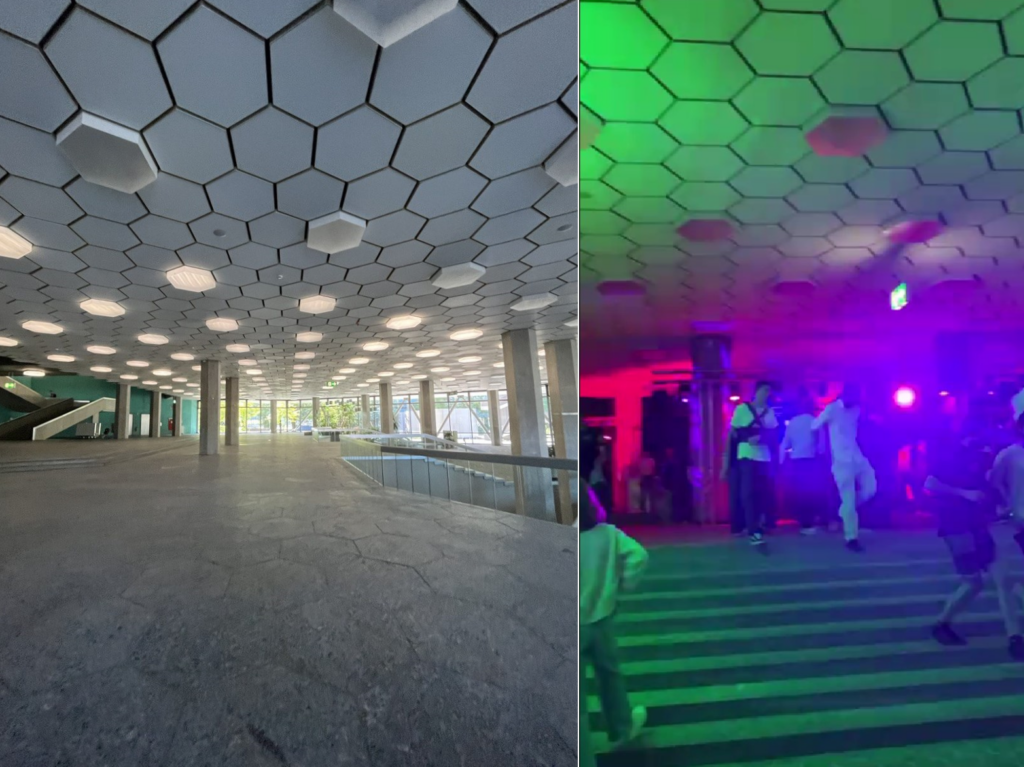
I found the versality and large hexagonal geometric space of the Physics Building at Honggerberg fascinating for the space can be converted into a multi-purpose arena for large scale events. The heavy dense marble or concrete and metal material used for the floor and the stairs also create hard reflections of sound and reverberations.
At lunch hour, one can hear throngs of people moving through the space by their voices, laughter, never-ending shuffling of footsteps and the sound of utensils in the distance of the canteen. Yet acoustically, the space is also extremely versatile for creating loud, reverberating beats with the low ceiling height. The beats do not seem echoey despite the large volume of the building’s central hall which may be attributed to the material properties of the wall, floor and ceiling panelling as well as the overall hexagonal geometry of the building.
Other interesting acoustic observations:
Buckminster Fuller dome at Vitra Campus
Clapping in this complex geometrical space, the reflections and reverberations are reflected on the tarp-like fabric material, generating an even more complex geometry of sound as each fold and tight fixtures of the fabric is at a different angle, tapering into a dome structure, creating an extremely multi-dimensional, traversal and acoustically stimulating soundscape from the echoey reverberation of a single clap alone.
02 – Exploring the Emotional Impact of Everyday Sounds
Everyday Situation 1: Tram Cabin
The sounds heard in the Tram Cabin are both natural and man-made. The sound of metal on the tracks creates a constant low screeching sound. Each time the tram stops and moves from its stationary position, it creates a cycle of a constant whirring rhythm of a machine starting and a unique beeping sound signaling the opening and closing of doors. At points where the tram needs to make sharper bends and turns, the joinery between the cabins also creates a sharp knocking sound as the hard material overlaps itself. Apart from the man-made sounds produced by the tram itself, sounds are also heard from the surrounding vehicles on the road such as honking, or the engine running from neighbouring cars or buses. These man-made machine sounds are then juxtaposed against the natural sounds produced by the human passengers in the cabin who create a myriad variety of chatter, laughter, talk. These transient, temporary sounds also greatly differ based on the type of passengers. There are resonances of young babies crying, their mothers trying to comfort them, people having conversations with others beside them or on the phone, people clearing their throats, sound of objects lightly knocking the walls and floor of the tram.
The interplay of these man-made and human sounds creates an auditory soundscape allowing me to learn more about the city of Zurich, for each city’s transport system and people’s spoken language greatly differs. The emergent sounds of the tram as a machine coexists with the natural sounds created by people. At times, the volume of the tram moving outweighs the human conversations, becoming more dominant, but due to the consistency of the machine running, they also become overheard and gradually fade into the sensorial background of space, allowing a passenger to subconsciously pay less attention to these “ambient” sounds. The weather also sometimes influences my perception of the soundscape on the transport network. For example, on a rainy day, the sound of rain pattering on the roof and windows of the tram and water dripping from umbrellas or the squeaky sounds of shoes against the floor surfaces creates a completely different soundscape from that of a sunny day. Hence, I find this space in the tram cabin extremely fascinating for its reactivity to all conditions such as the weather, people, and the interfacing of man-made and natural elements to eventually construct an auditory representation of an urbanised infrastructural landscape unique to Zurich as a city.
Listening to the repetitive droning of the machine whirring can sometimes evoke a calming effect. However, when there are too many sounds to process, it creates a disorienting and unsettling feeling. Listening to some extremely loud conversations or babies crying may also attract one’s attention and evoke feelings of annoyance and impatience for some. High frequency screeching sounds when the tram suddenly stops also creates an extremely piercing and uncomfortable feeling. Overall, the sound volume observed on the tram is of a comfortable range allowing one to remain in the cabin for extended periods of time and the distinct high frequency beeping sound of the tram stopping at each point alerts a passenger without being too disruptive in this transitory passage.
Everyday Situation 2: Studio Space
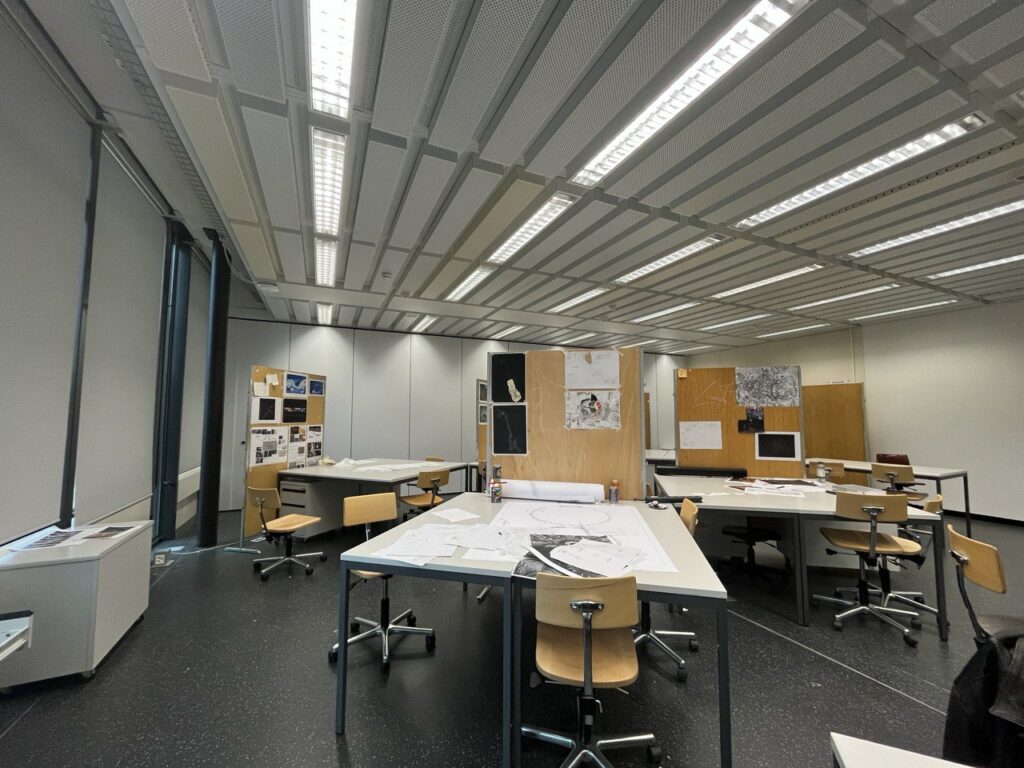

The Studio space is a completely enclosed environment of movable partition walls and a glass wall. The door to the studio is located in this enclosed vacuum where three other doors leading to other studios and a central staircase can be found. Each time one door opens, the sudden change in air pressure in the vacuum prompts the other doors to move slightly, and this sound mimics the opening of a door, creating an unwanted signal or disturbance to the users of the studio space each time someone opens the door to move through the vacuum corridor space.
In the studio itself, the sound of the ventilator forms a background ambient noise. On days where studio lessons are conducted, this ambient sound is completely overridden by the sound of people talking, chairs moving against the floor, knocking of chairs against the table, creaking sound of chairs, typing sound on keypads, paper shuffling, and footsteps among many more, reflective of the bustling human activity on the inside. On these days, the vibrant soundscape incites an energetic rhythm in my day, prompting me to be more alert, animated, and lively.
On other non-studio days, only the mechanical sound of typing on the keypad or the shuffling sound of paper and pencils can be heard for most people are concentrating on work. At these instances, the ambient sound of the ventilator becomes more prominent due to the low volume of other sounds, prompting me to be more focused to concentrate on productivity.
03 – Empirical and numerical estimation of room acoustic properties
Location: Studio Space
Estimated Dimensions of Studio (WxLxH) : 10 x 13 x 3.5m
Clapsound:
The reverberation time RT60 was calculated in my studio space.
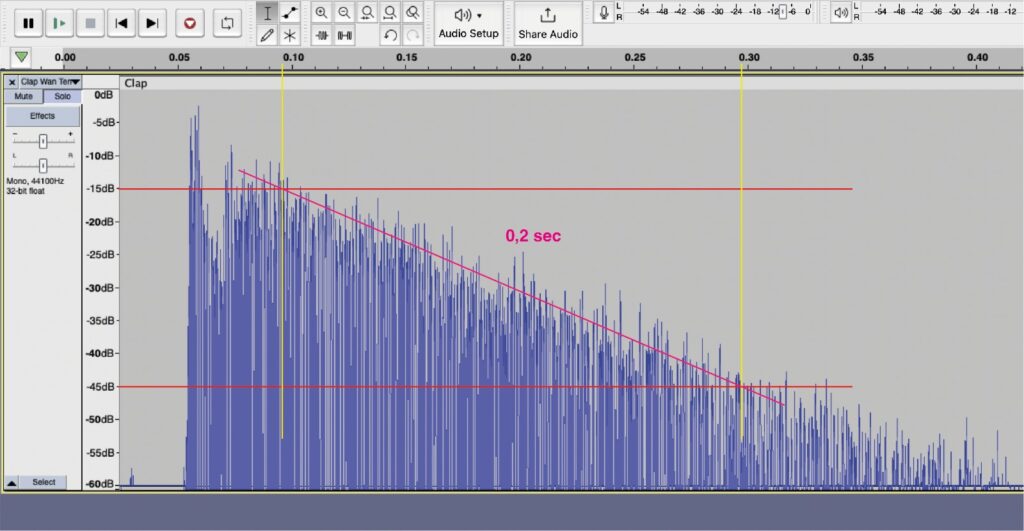
I measured a decrease of 30 db in 0.2 seconds.
Reverberation time: RT60 = 0.2 sec X 2 = 1.76 sec
This reverberation time seems appropriate for the size of the studio space, although expected that it might a bit longer.
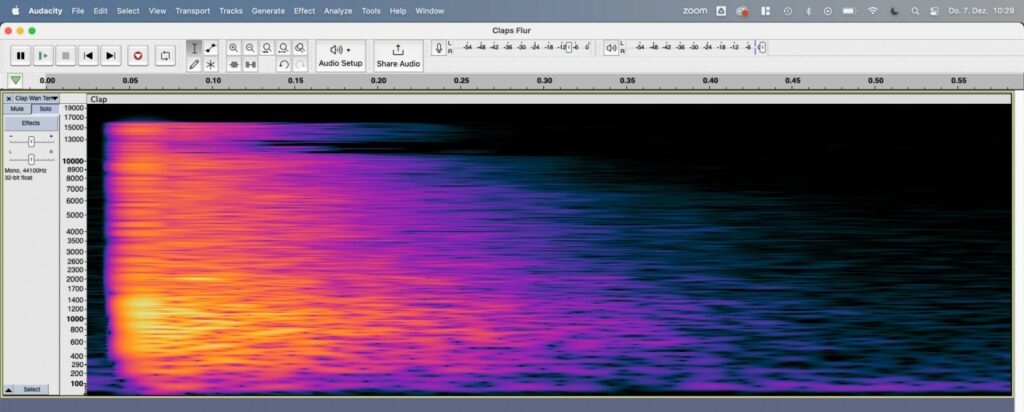
The spectrogram of the recording shows a clear and crisp sound clap and echoes are not clearly visible in the impulse decay.
04 – Characterization of Room Acoustic Treatments
Chosen space: Studio


The acoustically effective absorbers of the room are located on the floor and the ceiling. The floor is made of a vinyl-like material which slightly absorbs and muffles the sound of footsteps due to its softer surface. The ceiling is made of perforated metal sheets and the sound that travels upwards is diffused in the air pockets in the small holes which serve as sound absorbers. The many different surfaces and small pockets of spaces in the ceiling also naturally redirect the soundwave until it loses its energy.
While the room is of a regular rectangular box-like geometry, the positioning of the panels in a zigzag fashion adds a certain complexity to the geometry of the room by creating extended parallel surfaces within the room which reflect and redirect the soundwaves on the panels’ hard wooden surface.
The walls of the room are made of a PVC-like material for the partition walls on two faces, while one side is a full-length glass window, and the last side is made of concrete. The hard surfaces of these materials generally cause a high-frequency diffused reflection of sound. When the blinds are fully extended to cover the hard glass surface of the window, some sound frequencies may potentially be absorbed by the fabric material and the pocket of space between the blinds and the glass surface. This observation may be further explored to develop the materiality of absorbers in the space to become more acoustically effective while also being integrated with the visual language and aesthetics of the space. The metal perforation in the ceiling currently serves an acoustic purpose but may also be further developed to improve the visual impact of the acoustic measures by creating different aesthetical languages integrated with acoustic design elements.



